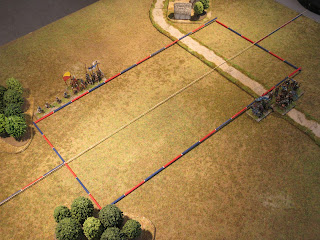We enjoy historical match-ups and found the Collision Course variant for deployment has become a welcome addition. The variant allows us to create encounter battles such as Montlhéry (1465) or Fornovo (1495). Players organise their armies in three equal size columns, of which one has marched on the board followed by the lead element of the second. Off table, the third column enters with the proper pip score, an uncertainty for which an opponent can exploit.
The late medieval period is our current interest and this past week we tested an alternative method to deploy our armies. The three columns organised for the collision course variant are now labelled the vanward, mainward and rearward. The three parts would no longer march on the table, but are placed within the deployment zone with players alternating the placement of their groups. The defender placed the vanward first, followed by the attacker placing his; the sequence continued until all groups and mobile baggage were on the board.
This offered an interesting alternative to the two deployment systems. The defender placing his vanward anywhere in his deployment zone, this need not be placed on the traditional right of the army. The attacker can select a position opposite the enemy vanward or elsewhere within his deployment zone. The sequence continues until all three groups and mobile baggage are on the board.
Two points, each element within the group must be in full edge contact with another, forming a column one element wide or a line four elements wide or any combination of the two. Secondly, groups may not be closer than 1BW at the start of the game. On a player’s first bound, further formation changes are done by expending pips.
Allies form a separate group of three elements giving a player the option to increase one of his remaining groups. Depending on their quality, allies may form the vanward of the army
Further
thoughts.
Last year,
I developed a dozen scenarios for the mid-17th century that could be
played randomly and outcomes would generate a rating for both players. The
rating influenced subsequent encounters developing nicely into a campaign
without the use of maps. Something similar can be designed for the mid-15th
century.
Burgundian Ordonnance L-R, vanward, mainward + mobile baggage, rearward.
Burgundian vanward
French vanward
French mainward + mobile baggage.
Burgundian rearward.
French rearward.
Ready for battle, Burgundy moves first.










No comments:
Post a Comment